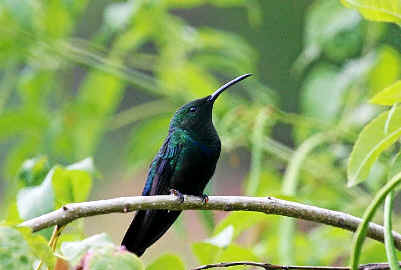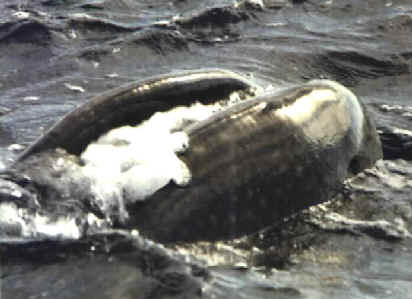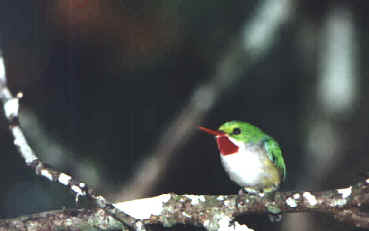
E-mail: font@focusonnature.com
Phone: Toll-free in USA 1-888-721-3255
or 302/529-1876
 |
PO Box 9021,
Wilmington, DE 19809, USA E-mail: font@focusonnature.com Phone: Toll-free in USA 1-888-721-3255 or 302/529-1876 |
FOCUS ON NATURE TOURS IN PUERTO RICO

The Green-throated Carib
is one of 5 species of hummingbirds
in Puerto Rico.
Links:
Cumulative List of Birds during FONT Puerto Rico Tours
Upcoming FONT Birding & Nature Tours in the Caribbean
The
following written by Armas Hill, of Focus On Nature Torus:
We
received an inquiry, a while back, from the editors of "Islands" Magazine,
asking some questions regarding our birding & nature tours in Puerto Rico:
What makes the tour unique?
What's a favorite aspect of the tour?
What are some things that a person wanting to join the tour should know?
And, when on the tour, is it easy or difficult?
Here we thought, in an e-mail bulletin, it might be good to share our answers to
these questions with you.
Probably what does make our FONT tours in Puerto Rico
"unique" (and we've done 27 such tours since 1990) is that we
spend much of our time in what might be called "the other Puerto
Rico", that is away from the resorts and the cruise ship docks, and
away from the metropolitan sprawl of San Juan.
Puerto Rico, with its countryside, is a beautiful island. Most of our time, during our PR tours, is in the western part of the island, where we visit a variety of habitats.
In forests, in the limestone or "haystack" hills of western Puerto Rico, there are not only interesting birds to find, there's an enjoyment of being in such a nice place.
The southwest corner of the
island (a dry habitat), both by the coast and inland, is a wonderful
place to be. There are cliffs by the sea, areas of lagoons, as well as some
places with cacti and others with luxuriant foliage. In all of these varied
places, we look at birds and other aspects of nature, such as the butterflies,
plants, and some non-avian wildlife.
From caves, at dusk, we see flying bats. Offshore, from a boat at sea,
we've observed not only oceanic birds (such as terns & tropicbirds),
but also the largest fish in the world (the Whale Shark).

A Whale Shark photographed during an offshore boat-trip
as part of a FONT Puerto Rico Birding & Nature Tour.
(Photo
courtesy of tour participant Marie Z. Gardner.)
From shore, in northwest Puerto Rico, we've seen the even-larger whales
themselves, Humpbacks, breaching (that is, jumping) sometimes
completely out of the water.
Elsewhere along the Puerto Rican coast, the sluggish West Indian Manatees
spend nearly all of their time in the water.
But regarding the birds themselves, during our tours, we see about 100 species of them. Some of these are visitors during the winter from the places to the north (following pretty much the same calendar as many human tourists).
Other birds migrate through Puerto Rico, using it as a stepping-stone between North & South America.
And yet other birds are in Puerto Rico all-year long. A number of these are "endemics", that is species that occur no where else in the world. There are just over 15 bird species found only in Puerto Rico.
They include:
a very rare parrot (one of the rarest birds in the world),
a rare blackbird with yellow wings (called locally the "Mariquita"),
a marvelous little bird called the Tody, about 4 inches in length, with
an emerald-green back, a white breast, yellowish belly, and a bright red throat.

The Puerto Rican
Tody,
seen nicely during every FONT tour on that island.
Among the other endemic birds, there are: 2 types of tanagers, 2 kinds of
warblers, 2 hummingbirds, a woodpecker, a cuckoo,
and an owl that during the dark of night gives a full repertoire of
sounds, including trills, chatter, and even a maniacal laugh.
If one were to have had a book
about Puerto Rican birds when JFK became president, two of the endemic birds of
the island would have been missing.
One, a nightjar (like a Whip-poor-will) that hides
by day, and catches insects around dusk and dawn and in between, was thought to
be extinct for over 70 years. It was re-discovered in 1961, and to this day, it
lives in a very restricted range in dense shrubbery the Puerto Rican dry forest.
The other bird that would not have been in the book is a small black-and-white warbler
that was discovered for the first time as recently as 1971. Even on populous
Puerto Rico that bird remained unknown to science for years! It's called the "Elfin
Woods Warbler" because it lives in small trees on mountaintops.
When many people think of nature in Puerto Rico, they think first of the rainforest, because a place known as "El Yunque" (a rainforest in the mountains east of San Juan) is well known. It is really a wonderful place, now preserved as a US National Forest. But, as noted earlier, it's just one of an assortment of habitats on the island. And so, it is just one of the places visited during the Focus On Nature Tours in Puerto Rico.
Yet one more member of the Puerto Rican cast of natural characters should be mentioned - the widespread Coqui Frogs. At night, their loud calls are heard continually. As easy to hear as they are, these little creatures, that are usually in trees, are hard to see. As frogs in much of the world have declined in recent decades, it's wonderful that the Coqui calls are such a prevalent and characteristic sound in Puerto Rican nature.
What's written so far has described what there is to like about the Puerto Rican touring. In summary, however, probably the favorite aspect of it is, yes, getting away from populated Puerto Rico, and being in that other world on the island that's beautiful and with nature. It sounds corny, but the contrast is tremendous.
Our favorite places in Puerto
Rico include these two:
1) the virtually-unvisited forest in the "Haystack
Hills", and
2) the cliff by the lighthouse at the southwest corner of the island.
Unusual birds have been
mentioned. and among them there have been "favorites". (It's hard to say just one. Well, no, we take that back - it's
the Tody!)
Our tour participants vote for their favorite birds at the end of the tours. The
Tody always wins!
A favorite restaurant is along the west coast of the island, jutting out over the water on a pier. The food there is really good, notably the seafood. People like it every day, and so do the Tarpons (large fish) in the water below the pier! During the day and after dark, people throw tidbits of left-over food into the clear water. The fish swimming about below in that water have clearly caught on to this apparently daily occurrence.
Joining a FONT birding &
nature tour in Puerto Rico is easy (although these tours are limited to small
groups of 6 or 7), and participation on the tours is easy as well. There's
no arduous hiking. The pace of the tour is not hurried. It's easy to pack
lightly as the weather is warm. It's not, when we go, too hot. Getting up early
is not a problem, as it's a wonderful time of day, and the best time for finding
the birds. And there's no concern regarding the meals. There's a good breakfast,
lunch ,and dinner every day.
During our tours, we stay in hotels, but those in more "natural"
settings. For example, in the hills in western Puerto Rico in the coffee-growing
country, or elsewhere, away from "busy" places where there's traffic,
a lot of buildings and many people. There are a number of nice places to stay in
Puerto Rico away from the crowds.
On a scale of 1 to 5 (1 being easy and 5 being difficult), let's say that a FONT tour in Puerto Rico is a 2. The hardest thing about it may be leaving the island when the tour is finished!